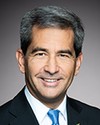Thank you very much.
Bonjour and good afternoon, everybody. I would like to begin by thanking the chairman and members of the committee for allowing me to speak here today.
My name is Shaun Padulo, and I'm the president of Heddle Shipyards, which is the largest Canadian ship repair and construction company on the Great Lakes. I'm proud to say that we are 100% Canadian-owned.
The company was founded in 1987, and today, we own and operate three of the largest shipyard facilities in Canada and fluctuate between 150 and 400 people, which is due to the seasonal boom-and-bust cycles. Since 2012, we have performed over 70 projects for the Canadian Coast Guard, totalling over $80 million, and we are currently on schedule to complete the CCGS Amundsen vessel life extension project at our shipyard in Port Weller. If we stay on course, it will be the first vessel life extension, VLE, in the history of the Canadian Coast Guard that has been completed on time.
Given the delays in building new ships, the VLE program is incredibly important, because it will ensure that the coast guard's current fleet remains operational. As a result, the government has allocated $2.1 billion for the upcoming VLE II program.
In terms of our business activities, we offer a full gamut of vessel life-cycle services, which include construction, repair and maintenance overhauls, and recycling.
Despite our success we are still hampered by the inconsistency of work, and the boom-and-bust cycles that inconsistency creates. The worst part of my job is overseeing layoffs on a seasonal basis because of what it means for my people, their families and retaining hard-won skills, experience and knowledge.
We are here today to discuss the national shipbuilding strategy, NSS. For me and all of my people, the NSS represents hope. It is potentially the solution to the boom-and-bust cycles that have crippled shipyards in Ontario for generations. At its core, the NSS is an important industrial and defence policy that can unite Canada and Canadians, while bringing a vitally important capability back to our country. There have been challenges, to be sure, but the challenges were inevitable in order to accomplish the enormous task of rebuilding the industry.
I'm incredibly proud of the large ships that are being delivered on the east coast by Irving, the west coast by Seaspan and in Quebec by Davie. It is important that all three regions are active in the NSS, because our country needs the capacity and more. The motto of Canada is A Mari Usque Ad Mare—“From Sea to Sea”. Canada is a maritime nation whether we like it or not, and we can't ignore that fact. Given current geopolitical events around the world, the NSS is more important than ever.
I've heard previous witnesses talk about the geostrategic importance of the NSS in terms of defence and sovereignty, but I would also like to raise awareness of its importance for economic security. The merchant fleet operating on the St. Lawrence Seaway moved 231 million tonnes of cargo in 2018—that's over $100 billion in value. Prior to Heddle reopening the Thunder Bay shipyard and Port Weller dry docks in 2016 and 2017 respectively, many of those merchant ships were dry docking in the United States. Those ships are now being repaired and maintained in Canada at our shipyards. The government work made available through the NSS is contributing to the revitalization of our shipyards and is therefore important to the commercial sector, which is vitally important to our nation's economy.
Ultimately, the NSS is a bipartisan issue developed and altered by both Conservative and Liberal governments, and it should be recognized for its significance as one of the most important industrial, defence and economic policies in the history of our country.
Although there have been many successes in the NSS, especially recently, there is room for improvement. I've heard repeatedly in previous committee meetings that there is not enough capacity in Canada to deliver ships on time and on budget, and that delays are the main driver of the cost overruns.
Ontario shipyards have the largest untapped capacity in Canada. Heddle's six dry docks constitute over 30% of the dry dock capacity in Canada, yet in 2020 and 2021, our average dry dock utilization was less than 40%. At peak employment, our facilities had 4,200 people, and today we have fewer than 200. Ontario has the largest manufacturing capacity in Canada, and we have two shipyards based in the industrial core of the province. We are currently building a ferry for the Ministry of Transportation Ontario, and the methodology we have adopted relies heavily on our southern Ontario supply chain, as well as suppliers all across Canada.
Heddle and Ontario are here to support our country. We have a solution for this committee to consider, but most importantly, though, our message to the committee is that Ontario should be included in the NSS in a meaningful way.
Much of the national shipbuilding strategy's benefits to Ontario have actually sailed through corporate boardrooms to real jobs in other jurisdictions. Our solution is to have Heddle Shipyards become a strategic partner for Canada to execute the VLE II program and construct vessels of less than 1,000 gross registered tonnes.
By partnering with Heddle, Canada will bring Ontario's industrial complex and manufacturing capacity to bear on the NSS. The partnership will provide a continuity of work for Heddle and Ontario, which will eliminate the boom-and-bust cycles and allow Heddle to continue to be a supplier that Canada can have to deliver projects on time and on budget.
In closing, I would like to thank the committee for allowing me to speak here today. It's been an honour and a privilege.
Thank you.










